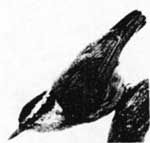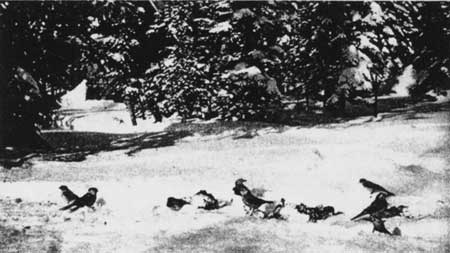Ornithological Notes of Interest – 1950
The summer of 1950 has produced an unusually rich array of observations which contribute to a more thorough understanding of the avifauna of Crater Lake National Park.
It has been presumed that the important factor determining the numbers of Farallon cormorants, Phalacrocorax auritus albociliatus Ridgway, on the lake is the status of the fish population. Cormorants reached their greatest abundance during 1939 when as many as 50 were seen at one time on the Phantom Ship.
During that summer large numbers of salmon were infested with a fungus, Saprolegnia,and were easily caught by the cormorants. There were abundant populations of small salmon in the 1940 and 1941 seasons end cormorants were common. From 1946 through 1949 the fish population was relatively low and few cormorants were seen. During the summer of 1950 rather extensive schools of small salmon could be observed. On the other hand, up to the 25th of August only a single cormorant had been observed. That was on July 25, near Wizard Island. The explanation of the failure of cormorants to appear in numbers in response to the increased fish population may lie in the apparently reduced numbers of cormorants on Upper Klamath Lake since it seems very likely that Crater Lake cormorants are actually visitors from Upper Klamath Lake. This may be an equally important factor in determining the number of cormorants on Crater Lake.
Several other interesting observations have been made on the lake. On August 16, Duane S. Fitzgerald, pilot of the launch, observed a great blue heron, Ardea herodias treganzai Court, on the shore of Chaski Bay. This is the second record for Crater Lake, the only previous record being that of the author of one on Wizard Island on August 26, 1949. On August 16 Fitzgerald observed 10 mallards, Anas platyrhynchos platyrhynchosLinnaeus, in Chaski Bay; the flock included several green-headed males. Only two previous records for the lake are known to the author: C. H. Merriam collected two on Wizard Island in August-September, 1396, and the author saw four in Eagle Cove on August 3, 1946. The summer of 1950 also produced the first definite records of the lesser scaup Aythya affinis (Eaton), on the lake. Two were seen by Denis J. Illige on Fumarole Bay on August 9; two were seen by Rollow S. Robinson and Duane S. Fitzgerald in Chaski Bay on August 12 and 13. Spotted sandpipers, Actitis maculariaLinnaeus, have again been observed on the shores of Fumarole and Cloudcap bays. California gulls, Larus californicus Lawrence, have again appeared in substantial numbers. The author’s first observation was two on July 2. Throughout August, from 25 to 40 have been observed perched on the rocks on the west side of Skell Channel. On August 13, Rollo S. Robinson saw a water ouzel, Cinclus mexicanus unicolor Bonaparte, at the Boat Landing. The appearance of water ouzels during the last part of July or the first part of August along the south shore of the lake occurs practically every year and perhaps may be best interpreted as an extension of the upward movement of water ouzels that begins in July.
A pair of nesting duck hawks, Falco peregrinus anatum Bonaparte, was discovered on Llao Rock by Denis J. Illige and the author on July 21. On July 23 young could be heard calling on the northeast face of the rock. Because of the inaccessibility of the site they could not be seen.
On July 29 Dr. William H. Baker and the author flushed a female and covey of plumed quail, Oreortyx picta picta (Douglas), in the rather dense forest of sugar pine, Douglas fir, and white fir on the north wall of Red Blanket Canyon. There were at least 11 chicks some of which could fly and some of which could not. This is the first definite record of breeding by this species in the park. This species is common at lower elevations in the Rogue River Valley but is rare in the park.
Field work in June in the southern part of the park produced some interesting results. In the ponderosa forest with intermingled clumps of chaparral, mostly Ceanothus velutinusDouglas, in the “Panhandle” and along the South Boundary between Sun and Annie creeks, substantial numbers of territorial males of the Calaveras warbler, Vermivora ruficapilla Ridgway x van Rossem; Warner Mountains fox sparrow, Passerella iliaca fulva Swarth; and Wright’s flycatcher, Empidonax wrightii Baird, were observed, establishing these as common breeding species in these areas.
Perhaps the most important ornithological development was the discovery of a breeding group of horned larks, Eremophila alpestris Linnaeus, on the northwest slope of Llao Rock near the summit. On July 21, Denis J. Illige and I saw about ten including a juvenal bird scarcely able to fly and being fed by an adult. On July 23 only a single bird was seen and none could be found on July 27. This record is somewhat remarkable because of its elevation (7700 ft.). However the habitat, other than the 40° slope involved, was a reasonably normal one for horned-larks. Most of the area is open with a predominant cover of sedge, mostly Carex brewerii Boott. There are some areas in which sedge is absent and the principal species present are flowering plants such asLupinus lyallii Gray, Phacelia leucophylla Torrey, Agoseris glauca Nuttall, andPolygonum newberryi Small. This area should be investigated in subsequent years beginning earlier in the season.
 Nuthatch |
Black-eyed pigmy nuthatches, Sitta pygmaea melanotis van Rossem, were unusually common in the park this summer. During June flocks containing as many as 20 were observed in the ponderosa pine in the “Panhandle.” Later, smaller numbers were observed in many parts of the park, including a single bird in the clump of white-bark pines on the summit of Llao Rock.
During June large flocks of Western evening grosbeaks,Hesperiphona vespertina brooksi Grinnell, and red crossbills,Loxia curvirostra Linnaeus, were observed in the “Panhandle” and along the South Boundary between Annie and Sun Creeks. Both species were feeding on ponderosa seeds. Later in the summer crossbills were observed occasionally at various places in the park, but rarely with more than five or six in a group.
Among the species whose population and distribution in the park fluctuate markedly from year to year is the lazuli bunting, Passerina amoena (Say). The summer of 1940 was a season of maximum population and maximum distribution; singing males were quite common at Park Headquarters, on Castle Crest, and in Munson Meadow, as well as in the more suitable habitats at lower elevations. During 1946 the author was unable to obtain a single record anywhere in the park; a few were observed during 1948. During the summer of 1950 a few singing males were noted at the headwaters of the East Fork of Annie Creek, and a few in Wheeler Creek Canyon near the East Entrance.
My ten-acre study plot in upper Munson Meadow had five pairs of Lincoln sparrows,Melospiza lincolnii alticola Miller and McCabe during the summer of 1950 compared to six during the summer of 1948. The approximate areas of the 1950 territories in acres were 1.2, 0.5, 0.25, 1.1, and 1.5. Because of the heavy snowfall the breeding season was late. Territorial defense did not develop until the first and second weeks of July, for the area was under snow until the first week of July. The lateness of the breeding season is best illustrated by citing Aldrich’s observation of juvenal Lincoln sparrows in the same area on July 12, 1937.
On August 11, 1950 the author observed a single western bluebird Sialia mexicana occidentalis Townsend, at 7800 feet on Dutton Ridge It was in a feeding flock of mountain bluebirds, Sialia currucoides (Bechstein). Doubtless this is another example of upward movement by this species as observed by Dixon in 1944 and 1945.
Although Cassin finches, Carpodacus cassinii Baird, appeared to be somewhat less common than usual, what appears to be our first definite observation of a nest was recorded. The author found this nest in a Shasta fir at Kerr Notch on July 28. At that time one young had left the nest and was being fed by the male. There were at least four more young in the nest.


